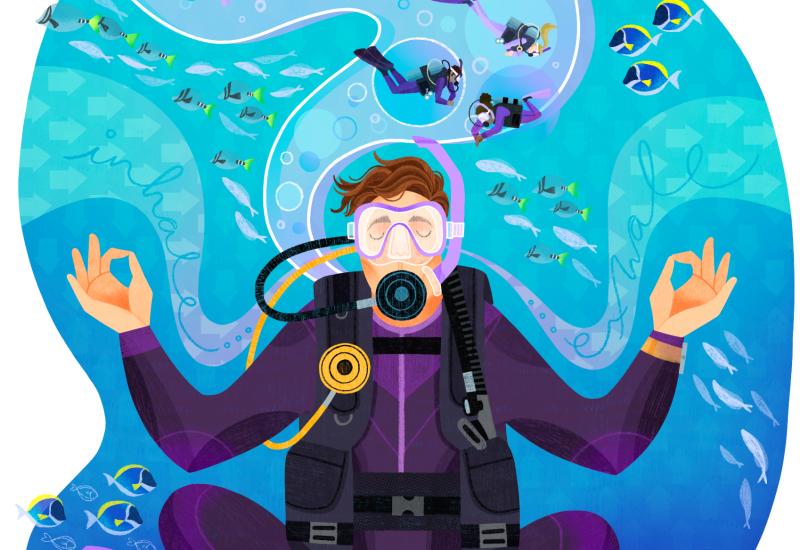What It's Like to be a Professional Mermaid

Matthew AddisonProfessional mermaid, Linden Wolbert, swims with a shark.
My trajectory to becoming a professional mermaid was a natural one. I grew up in a family of swimmers and always had a passion for the ocean and swimming.I learned to swim at the same time I learned to walk. Later, I went to Emerson College and I studied film and environmental science with a dream of starting a career in the underwater realm. Then I moved out to L.A. and worked as an underwater filmmaker and underwater scuba model. I saw freedivers for the first time while working on a documentary about them in Grand Cayman. That’s when I first saw monofins being used. I asked World Champion Canadian freediver, Mandy-Rae Cruikshank, if I could borrow hers to try it. Then I thought, wow, “what if I were a mermaid talking about the ocean instead of a random talking heads like in many documentaries?” And that’s how it all started.
What is a day in the life of a professional mermaid like?
There’s never a standard or normal day in the life of an “entrepremer,” as I call myself. Some days, I’m answering emails or doing interviews. Others, I’m doing live performances or helping other people train to be mermaids and mermen by learning how to move their bodies underwater and be relaxed and calm in the aquatic element.
My days’ work as a professional mermaid might include product launches for my line of monofins, performances for kids birthdays or training people in mermaiding/mermanning skills for an underwater music video. I might be traveling on boats and freediving with animals for my educational Mermaid Minute series. I never know what I am going to be doing. My life can always be completely transformed or changed with one email or one phone call. It’s just a lot of fun! I love my job and am so excited the world has supported my passions for so many years–that I’ve had this opportunity to be a mythical creature sharing the magic of our oceans.
What do you wear as a professional mermaid?

MermaidsInMotion.comLinden Wolbert relaxes on the beach in her full mermaid outfit.
I have several different tails made of silicone and neoprene, seashells and other fun tops. For the first silicone tail I had, I spent 7 months working with Hollywood special effects Allan Holt artist using a technique called biomimicry. It weighed thirty-five pounds. We took our inspiration from the fastest fish in the world–sailfish, swordfish, tuna and great white sharks–to design its crescent moon-shaped tail fin. I wanted it to be really fast.
Now I’m on to version 2.0. And my latest silicone tail weighs 50 pounds and is neutrally buoyant, meaning it doesn’t sink or float in the water and it looks very realistic. I have a bunch of other tails I wear including a neat array of neoprene tails embellished with sequins sewn on by hand that are reserved for swimming pool performances so I don’t drop bits and bobs in the ocean.
One thing I don’t wear is a mask or goggles, or any breathing apparatus. I’m a freediver and can hold my breath for just over five minutes, my personal best static breath hold.
Speaking of that, what sort of fitness do you need for the job?
You need to be in good cardiovascular health but also good psychological health as a freediving mermaid. You need to stay calm so your heart rate stays down while you’re swimming and diving so you can have a good breath hold. It’s important to remain very relaxed and have confidence in your body’s capabilities.
I learned to freedive from world champion freedivers and always have a safety team with me. If you want to be a professional mermaid, get professional training for freediving so you understand the safety protocols and understand your physiology and psychology. I never dive or swim alone. Ever. Always surround yourself with a competent safety team.
To stay in shape for mermaiding I hike, walk, do yoga and pilates, swim and freedive. I’m also a meditating mermaid. An aquatic fitness routine is the best exercise in the world for me. So I swim laps in the pool and do ocean swimming when the weather permits. If you want to get six pack abs, the best way to do it is with proper monofin movement, which is all coming from your core. If you’re doing it properly you’re going to feel it in your stomach and core muscles, and get pretty ripped. I just love exercising in the water!
How has scuba diving played into your evolution?
I’m a PADI master scuba diver with over 800 dives. In my early and mid 20s I worked for several years as an underwater model for PADI, demonstrating a variety of skills and techniques for their training materials and marketing campaigns. I got to travel the world and dive for several years. The dream! My travels with PADI were a huge and formative part of my underwater career and experience. I’m thrilled PADI has rolled out its mermaid specialty course so that so many mermaids and mermen can learn proper safety protocols.
How do people react to you?
It’s pretty much all smiles, no matter who or what or where. Besides sharing the magic of our oceans with anyone who will listen or watch, I love making people happy! When kids ask what my magical power is as a mermaid, I say I have the superpower to make people smile. When I’m a mermaid, I have an indelible smile on my face and it’s contagious!










